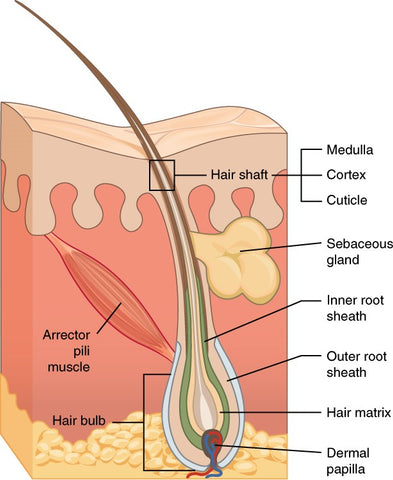Collection: Hair Vitamins
Hair structure

A single strand of hair mainly comprises of hair root, shaft, and the end of your hair.
Hair root
The hair root is the part of the hair attached to the skin of your scalp. It has a layer of actively replicating cells called the hair matrix. The hair follicle is an opening deep down in the skin of your scalp where the hair root begins. At the beginning of a hair follicle, lies a pear-shaped structure known as the hair bulb. Cells of each hair follicle divide to produce the hair shaft.
Hair Shaft
The hair shaft is the visible part of the hair on your head. It has three layers: An inner core known as the medulla. The medulla is flanked by a middle layer known as the cortex, which makes up the bulk of your hair fiber—and is packed with keratin proteins, amino acids, and fats. The keratin proteins form a protective shield surrounding your hair shaft and help your hair stay elastic, supple, strong, and youthful.
Going outwards from the shaft cortex is another transparent layer of overlapping cells making up the shaft cuticle that serves to protect other layers of your hair shaft.
Towards the base of each hair follicle, the shaft cuticle is then enclosed in three layers that form the inner (internal) root sheath.1
The cells of the internal root sheath start from the root of the growing hair and extend up to the hair shaft. They are the extensions of the bottom cells of the hair matrix.
Surrounding the internal root sheath is an external root sheath, which is an extension of the outer layer of your skin (epidermis) of your scalp.
Finally, there’s a thick glassy membrane covering the hair root, attaching it to the layer that lies below the epidermis known as the dermis.
Hair nutrition
Your hair is what you eat! Just like your body, your hair also needs nutrition. In fact, taking a well-balanced diet is one of the key factors to keep your hair healthy and youthful. A lack of sufficient nutrients packs quite a negative punch on both the hair structure and hair growth. It can not only lead to a condition called acute telogen effluvium (TE), which is a transient hair loss due to sudden weight loss or reduced protein intake but also induces diffuse alopecia (widespread hair loss) when your niacin (vitamin B3) intake is not up to the mark.2
Supporting your hair through a healthy, wholesome diet ensures that you feed it with essential vitamins (in particular B complex, biotin, and vitamin C), minerals (like zinc and iron), fats (omega-3 fats), and amino acids.
Daily Care Tips
1. Wash Your Hair Less Often
That’s right! While we all know that using a quality shampoo to rid of the dirt buildup is a great part of haircare, over-washing tends to strip your hair of its natural oils, making it drier, duller, and lifeless. Moreover, whenever you wet your hair, it expands from within. Repeated washing pushes your hair cuticle up, causing more breakage and split ends.3
Don’t wash your hair more than what is required. Instead, limit washing to once or twice a week. During your non-wash hair days, if your hair looks greasy and dirty, try using a dry shampoo that eliminates the greasy look and leaves your hair squeaky clean.
2. Deep Condition your Hair
We all know that conditioners help soften your hair, minimize tangling, and smooth out frizz. But don’t be afraid to go that extra mile for achieving a flawless look by deep conditioning your hair to lock in the moisture and get high-shine hair.
3. Don’t Use Hot Water r
Rinse your hair with cool or lukewarm water as hot water can dry it out and damage it.
4. Wrap your hair instead of air drying
The old concept that letting your hair air dry is the best way to dry it for preventing hair damage is now a myth. That's because when your hair comes in contact with water, it swells. The longer the water remains in your hair, the greater the swelling, and the more cuticle damage it incurs. In fact, the hair damage from water somewhat equals the damage from using a hair drier.4
So, first, wrap your hair in a towel and gently squeeze to get the excess water out. Then, blow dry your hair by keeping your dryer on the lowest setting, while handling the dryer about six inches away and circling it around in all directions.4
5. Don’t Rub your Hairg
Blot your hair with a towel. Avoid rubbing as it will cause friction and damage your hair’s cuticles.
6. Choose your Pillowcase Wisely
Cotton pillowcases draw out the moisture from your hair. Silk is a friction-free fabric as opposed to cotton that causes a lot of friction. Use a silk pillowcase to protect your hair while sleeping and wake up with less frizzy and more smooth, manageable hair.
